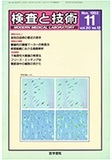Japanese
English
- 有料閲覧
- Abstract 文献概要
(抄録)背景:胎児ダウン症候群の全体の約35%は,全妊娠婦の第2三ケ月期に母体の血清アルファフェトプロテインを測定することによって検出することが可能である.最近のケースコントロール調査の結果では,血清中の非結合エストリオールと絨毛ゴナドトロピンを測定することにより,この検出率を約2倍に引き上げることができることを示している.ダウン症の胎児を妊娠している母親では血中エストリオールが異常低値に,また絨毛ゴナドトロピンが異常高値になることを示唆している.
方法:われわれは予期的に妊娠の第2三ケ月期の女性および青年女子25,207名をスクリーニングし,3つの血中マーカーをすべて測定するとともに母体年齢も含めたアルゴリズムに従い,それぞれに胎児ダウン症になる危険率を算出した.この手順に従って,1,661名(6.6%)の妊婦が最初に第2三ケ月期における胎児ダウン症の危険性が1対190以上の確率で出現すると判断し,さらにそのうちの962名(3.8%)に妊娠週数を確認した後に羊水検査による染色体分析を勧めた.妊娠週数は最終月経周期の初日を基準にして算定し,可能であるときは超音波検査で決定した.
Abstract Background. Approximately 35 percent of all cases of Down's syndrome in fetuses can be detected by measuring maternal serum alpha-fetoprotein during the second trimester in the general population of pregnant women. Recent case-control studies indicate that this detection rate could be approximately doubled by measuring serum levels of unconjugated estriol and chorionic gonadotropin, which are abnormally low and abnormally high, respectively, in women carrying fetuses affected by Down's syndrome.
Methods. We prospectively screened 25,207 women and adolescentsin the second trimester of pregnancy and assigned each a risk of fetalDown's syndrome with an algorithm that took into account measurements of all three serum markers in combination with maternal age. On this basis, 1661 subjects (6.6 percent) were initially assigned asecond-trimester risk of fetal Down's syndrome of at least 1 in 190, and 962 (3.8 percent) were offered amniocentesis for chromosomalanalysis after verification of gestational age. Gestational age wasdetermined on the basis of the first day of the last menstrual period or, when available, by ultrasonography.
Copyright © 1992, Igaku-Shoin Ltd. All rights reserved.


